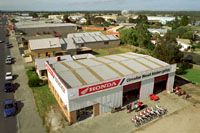

| Advantages of Low Altitude Photography |
 Why
Low Altitude?
Why
Low Altitude?
Aerial photography has traditionally been performed from light aircraft,
which are restricted to a minimum altitude of 1000 feet over built-up
areas and 500 feet elsewhere.
Unless photographing very wide areas that require it, this altitude is often less than ideal. There are a number of problems: For a start, atmospheric haze increases with altitude, affecting picture clarity.
Also, if a smaller object such as a house is being photographed, a telephoto lens must be used, requiring a high shutter speed to prevent motion blur, which in turn requires fast film that tends to be grainy and have poorer contrast.
Solutions
The above issues are well known, and are a constant headache for the conventional
aerial photographer, who may use filters to help with the haze, and "fast"
lenses which pass a lot of light to try to compensate for the high shutter
speed.
Low-altitude aerial photography avoids these problems altogether. At lower altitudes, there is less atmospheric haze between camera and subject, resulting in noticeably clearer photos.
Also, by being closer to the subject, a telephoto lens is not required, which allows slower shutter speeds and more light to the film. This in turn allows slow, fine-grain, high-contrast film to be used.
 A
Fundamental Difference
A
Fundamental Difference
There is a third advantage, involving the composition of the photograph.
Consider a situation where we need to photograph a house.
From the normal operating height of a light aircraft, to make the house fill the frame, one would need a telephoto lens.
The resulting "tunnel vision" misses out the horizon and all the other features between the house and the horizon.
Telephoto lenses also destroy perspective, a critical element in our depth perception, where closer objects appear bigger.
 Getting
Closer
Getting
Closer
In contrast, by taking the photograph from a very low altitude such as
150 feet, a wide-angle lens can be used, making it possible to see not
only the house in great detail, but also the horizon and the background
area all the way to the horizon.
This, combined with the enhanced perspective effect of the lens, creates a strong sensation of "being there".
Conclusions
With the recent availability of miniature, lightweight video and remote
control equipment, it is now feasible to use alternatives to light aircraft,
and place a camera at this "magic" height.
We chose the remotely piloted helicopter as a good platform, because of its compactness, manoeuvrability and height flexibility.
Next time I'll be looking at methods to combat vibration - the aerial
photographer's curse!
Web Site: HiCam Aerial Photography
(These articles first appeared on the Hi Cam web site
and have been reproduced with the owner's permission).